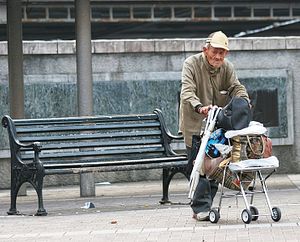The Abe administration has come under fire for rejecting a government report that warns the country’s national pension benefits will not be able to sustain the daily cost of living for elderly couples after retirement.
Earlier this month, the Financial Services Agency (FSA) highlighted an income savings gap of $186,000 for retired couples who live until the age of 95 – or 30 years after retiring. People aged over 65 make up 25 percent of Japan’s population, and that number is projected to reach one-third by 2050. Accordingly, social benefit costs, which are currently about a third of Japan’s annual budget, are set to balloon by 50 percent in the next two years.
Finance Minister Taro Aso, who also serves as deputy prime minister is at the center of the social security controversy after refusing to endorse the panel report. According to Aso, the findings sparked mass “misunderstandings” and did not represent the reality of the situation.
Aso faces a barrage of criticism from opposition parties such as the Constitutional Democratic Party, the Democratic Party for the People, and the Japanese Communist Party, who pressed the cabinet to answer constituent concerns on how they will survive after retirement. A no-confidence motion was submitted jointly to the House of Representatives by five opposition parties calling for a national assembly meeting to rebuild the social security system. They also demanded Prime Minister Shinzo Abe’s resignation, saying, “the Abe administration response to pensions and consumption taxes … is extremely irresponsible.” The measure was voted down, slashing opposition hopes for a dissolution of the lower house. This setback follows the opposition’s earlier unsuccessful no-confidence vote against Aso last week.
The government’s attitude has enraged voters. Many worry they won’t be able to rely on the pension in old age. Demonstrations in Tokyo erupted last week, with angry voters calling for the return of a national pension. Demonstration organizers say more than 2,000 people attended. Protesters chanted in Japanese “pay a pension we can live on” and lashed out at the government’s failure to take the pension fund issue seriously.
A public pension system reform dubbed the “100 year relief plan” was introduced in 2004 with the aim of making the pension system sustainable for the next 100 years. In 2014 the government assured the public the national pension fund was on track with labor market and economic growth projections, with no major review needed.
However, the government is now backpedaling on past assurances, explaining that the size of pension benefits will need to be adjusted to factor in “macroeconomic slides” such as a shrinking working age population and economic growth forecasts. At the same time, as Japan’s traditional lifetime employment model is gradually phased out in favor of contract and temporary workers, fewer people are benefiting from compulsory company pension payments made to full-time employees that would boost retirement savings. Based on the FSA report’s findings, local media have branded the “100 year relief plan” a lie.
The Abe administration’s mishandling of the national pension fund comes ahead of the upcoming summer upper house elections. The cabinet approval rating has slipped to 47.6 percent, according to a Kyodo News survey.
Taking advantage of the rise in voter anger, the Constitutional Democratic Party of Japan stepped up their pension policies. The opposition party promised to ensure the national system is reliable for retirees without huge savings, with a particular focus on improving medical and nursing services.

































